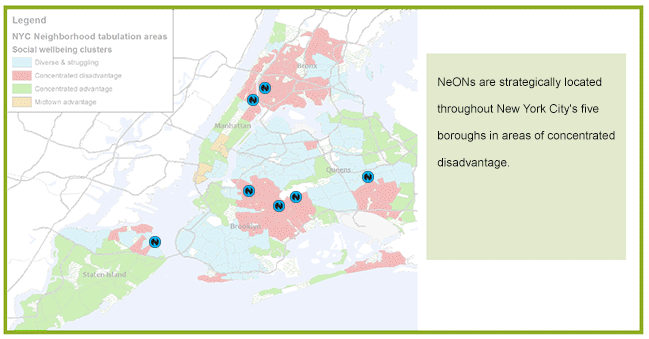
 Neighborhood Opportunity Network311
Neighborhood Opportunity Network311 Search all NYC.gov websites
Search all NYC.gov websites
Reports and Evaluations
University of Pennsylvania Study
The University of Pennsylvania Study is a round-breaking multi-year study produced by University of Pennsylvania’s School of Social Policy & Practice looked at impact of the arts on neighborhoods that demonstrate concentrated disadvantage across social wellbeing indicators, and those that they term more diverse yet struggling. The report makes three profound conclusions, each of which is addressed by the NeON ArtsSM model.

FINDING 1:
- The impact of the infusion of arts and cultural resources into these disadvantaged and struggling neighborhoods goes beyond enhancing access to the arts – it actually impacts well-being in a broad sense – including health, educational attainment and safety.
Studies already show the positive impact of the arts on young people involved in the justice system; now we know that it has a major impact on their communities as well:
- Involving young people in the arts encourages them to develop competence, self-esteem and form healthy, pro-social relationships.
- Arts programming and education in criminal and juvenile justice settings transforms behavior. Studies suggest an increase in self-control and improved conflict resolution skills, and a decrease in violent behavior and rule-breaking among arts program participants.
FINDING 2:
- The return on investment for infusing cultural resources is actually significantly greater in challenged neighborhoods; economically-challenged neighborhoods that have cultural resources show greater gains in overall well-being including lower serious crime rate; in other words, pouring cultural resources into an advantaged neighborhood will NOT produce the same results (in terms of improved safety, etc) as it does when infusing them into a disadvantaged neighborhood.
DOP NeONs are located in the neighborhoods described in the report as at “concentrated disadvantage” or struggling and are precisely the neighborhoods in which the impact of the infusion of cultural resources would have some of the greatest impact.
- In terms of low education attainment:
- The Community Districts encompassing DOP NeONs and NeON Satellites neighborhoods made up 9 of the bottom 15 (and 10 of the bottom 19), including the second and fourth worst in the city – Brownsville (61.4%) and the South Bronx (63.4%). The other three CD’s in the bottom five are all CD’s in the South Bronx (1 and 2, 3 and 6, and 5) that surround and are contiguous with CD 4, where the South Bronx NeON is located.
- Manhattan’s Community District 10, where the Harlem NeON is located, was recently ranked 47 out of 59 for high school graduation rates citywide, with a rate of only 67.8%.; the surrounding districts rank 43rd (68.5%) and 52nd (65.1%).
- And Community Board (CB) 10 (where the Harlem NeON is located) has identified arts and community development among its top needs in its formal FY16 Statement of District Need. As CB10 states “Community Board 10 is in need of a Community Recreation and Cultural Center (CRCC) to provide a cohesive force for our community, where young people can play and learn and grow...
FINDING 3:
- The most effective way to infuse cultural resources into the overall ecology of a neighborhood is through a social NETWORK approach that connects institutions, programs, and neighborhood resources: forging collaborations between local on-the-ground resources, community-based organizations, non-profits, and government institutions.
This is what NeON Arts already does, as it follows a collective impact model – defined in part as a cross-sector collaboration: public and private, involves nonprofits, governments businesses, agencies, foundations.
- NeON Stakeholder Groups - made up of local community members - work as collaborative bodies to articulate community needs, activate an effective artist selection process, and choose projects that meet the needs of their communities. This process serves a community-strengthening, capacity-building, and power-sharing function that also enhances civic engagement.
- Stakeholder Groups often choose small, local organizations and individuals that are reflective of the community and that may not have access to more traditional forms of arts funding and that have particular cultural competence in working within these communities. In turn, the small organization and individuals also benefit from Carnegie Hall’s resources, contacts and experience, and thus build their own capacity.
- The NeON Arts Network:
- Over 100 unique organizations have applied to work with DOP.
- 30 new community partnerships have been forged across the 7 NeON neighborhoods.
- Over half of the participating arts organizations have annual budgets of under $250,000.


